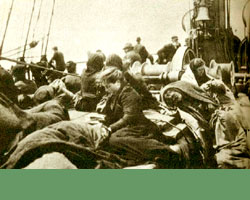
IMMIGRATION
 New World |  New Beginnings | |
 New World |
The harsh economic conditions (drought and crop failure in the 1840's and diminishing land availability for farmers), political unrests in the 1848 and the resistance to compulsory military service played an instrumental roles in the decision-making process for the Bohemians leaving their homeland. These were the beginning years of steady emigration from Bohemia and Moravia to he United States. In the 1860s transatlantic companies acquired steam powered ships and succeeded to cut the voyage to the New World from 3 months to 2-3 weeks and the number of immigrants increased. Ironically, the inexpensive american wheat and grain imported to Europe in the 1880s and 1890s created a crisis among the European farmers. After exploring the possibilities of aquiring 160 acres of land undr the Homestead Act of 1862 some decided to relocate to the United States. To them 160 acres seemed like a gold mine compare with their small 5-12 acres plot. The immigration flow slowed down in the early 1920 because of the quotas imposed by the Congress on the newcomers of Slavic origins.
"If we want the American race to continue to be predominantly Anglo-Saxon-Germanic, of the same stock as that which originally settled the United States, wrote our Constitution, and established our democratic institutions; if we want our future immigration to be chiefly more of kindred people ... easily assimilable, literate, of a high grade intelligence, then the simpliest way to accomplish this purpose is to base the percentage limitation upon an earlier census than 1910 ... i.e., before southern and eastern Europe had become the controlling element in our immigration."
(Scientific Monthly 1922, article by Harvard professor Robert Ward. Cited from Ellis Cose: A Nation of Stranger's).
It is estimated that between the years of 1848 and 1914 there were approximately 350 000 new immigrants from Bohemia. However the estimated numbers are just that - an estimate. It was not unusual to be assigned a different ethnic origin by the immigration officers. Czech lands were still a part of the Austro-Hungarian Empire of many nationalities and many languages. A Bohemian immigrant not knowing English sometimes had his origin altered as well as his name.
"If we want the American race to continue to be predominantly Anglo-Saxon-Germanic, of the same stock as that which originally settled the United States, wrote our Constitution, and established our democratic institutions; if we want our future immigration to be chiefly more of kindred people ... easily assimilable, literate, of a high grade intelligence, then the simpliest way to accomplish this purpose is to base the percentage limitation upon an earlier census than 1910 ... i.e., before southern and eastern Europe had become the controlling element in our immigration."
(Scientific Monthly 1922, article by Harvard professor Robert Ward. Cited from Ellis Cose: A Nation of Stranger's).
It is estimated that between the years of 1848 and 1914 there were approximately 350 000 new immigrants from Bohemia. However the estimated numbers are just that - an estimate. It was not unusual to be assigned a different ethnic origin by the immigration officers. Czech lands were still a part of the Austro-Hungarian Empire of many nationalities and many languages. A Bohemian immigrant not knowing English sometimes had his origin altered as well as his name.